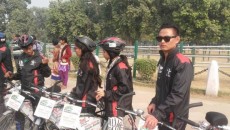People for Peace Cycle Rally — “Paid Activism” versus Real Activism
The 3rd “People for Peace Cycle Rally” concluded at Indo-Pak Wagha Border Amartsar – Lahore on Wednesday 13, 2016.
This time cycle rally was between India Gate and Wagha Border Lahore. While concluding the rally, students from Indian universities expressed their resolve to continue their initiative in future. They believe that such initiative would work to pull both nations closer and avoid power mania.
This year, the rally was started on January 1, 2016 from India Gate and over 50 students kept traveling to Wagha border despite of terror attack on Pathankot Air Base of India. There were fears that rally might be terminated before reaching Wagha Border because hawks in Indian media and in New Delhi blamed Pakistan for terror attack on Pathankot Air Base. However, Indian youth continued rally despite of grave situation and harsh reaction of main stream India media after Pathankot incident. Attack was conducted just after one day Peace rally started from Gate of India.
Indian youth under the leadership of a young activist Praveen Singh initiated the first cycle rally in 2013 from Kanyakumari to Wagah Border while the second was taken out from Delhi University North Campus to Wagah Border in 2014. Kanyakumari to Wagah Border cycle rally was planned to attend by 13 students but seven students fell sick before the journey. Five students peddled from Kanyakumari and they went to Bangalore University and St Joseph’s College and collected signatures to support their expedition. The signatures collected during the campaign were sent to the Government of India and the office of the Pakistani High Commissioner in Delhi. Five more students joined the rally on way students covered a distance of 3,800 kms on bicycles and reached Wagah border on August 15, 2013.
Second rally was another success and this time 50 students of Delhi University started cycling to Wagah Border on August 1 to celebrate Independence days of India and Pakistan. This rally started from Arts Faculty, North Campus of Delhi University and students kept traveling to Wagha border while promoting peace at different educational institutions of Indian Punjab and Haryana. Third rally started on January 1, 2016 and reached Wagha Border on January 13, 2016.

This “People for Peace Cycle Rally” is not sponsored by any international donor and Indian students are doing this great initiative through their own resources and this factor could be a ‘success factor” behind this initiative because there is no donor that could dictate students to “do this and not to do this”. We have been watching that donor-funded Peace initiatives usually end when funding is stopped or donor needs “Something different”. One can cite a list of such initiatives that died of when funding was seized in South Asia. Donor-funded projects and initiatives are usually “Demand and Supply Driven” and “Activism” has marginal role in such initiatives. There is no doubt that funding is necessary as “appreciative measures” for the continuity of peace initiatives but not as “Designer”. “Designer” should be passion and commitment of people to design, plan and execute initiatives. Participants of Peace rally call them “Peace Ambassadors” and this passion of “Peace Ambassadors” is driving force behind the success of rally despite of Pathankot terror incident. This rally could have been terminated after Pathankot incident if there could have been an international donor or “Master” behind this rally. International donors usually avoid controversies and “serious diplomatic situations” and eject themselves from initiative or seize the initiative when such initiative is being criticized by main stream media of any country.
We observe that donor-funded projects go only to registered Non-Government Organisations (NGOs) and NGOs provide jobs to activists and with the passage of time these activists become a part of bureaucratic system and stop working when funding is stopped. The concept of “No Money—No work” is against the soul of activism but NGO sector injects this corporate sector system of “No Money—No work” into activism— resulting in the death of activism.
NGO sector believes that it provides capacity building, advocacy and trainings to lower strata of society but reality is otherwise. NGO system effectively killed activism during the last 40 years in South Asia.
NGO sector was built stronger than ever during Reagan-Thatcher years and governments in developing countries began looking at NGOs for providing support in health care, education and capacity building because a flood of foreign funding to NGOs was the theme of the decade. Aid to ‘developing’ nations also began increasingly via NGOs rather than through government organs. NGOs actually became “Soft Power” tools of superpowers during this era in South Asia.
Activism we saw in late 60s and early 70s died of or killed by “Paid Activism”in South Asia. I remember an Indian movie of early 70s— “Sagina” (featuring Dilip Kumar) that represents how an Activist Dilip Kumar is trapped in NGO system and at last he lost qualities of leadership. The film won the 1974 Filmfare Best Art Direction Award.
Disclaimer:
This article is written by Agha Iqrar Haroon. The views and opinions expressed in this article/Opinion/Comment are those of the author and do not necessarily reflect the official policy or position of the Dispatch News Desk. Assumptions made within the analysis are not reflective of the position of Dispatch News Desk.







